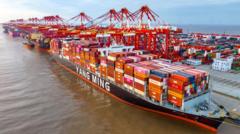The global economy is facing a complex landscape as the specter of 'Trump 2.0' emerges, with predictions for modest growth at around 3.2% according to the International Monetary Fund. This creates an environment filled with uncertainty, particularly concerning inflation and interest rates, while the potential for new tariffs looms large over international trade relations.
A recent interest rate reduction in the U.S. has been welcomed by borrowers, but the Federal Reserve has warned against further cuts, indicating a cautious approach in battling inflation which saw slight increases in major economies like the US, Europe, and the UK in November. The underlying challenge for many central banks remains achieving their inflation targets amidst economic growth stagnation.
Some analysts, including Luis Oganes from JP Morgan, warn that uncertainty about Trump's potential policies, especially regarding tariffs, could significantly affect global growth. Trump has already hinted at a more isolationist stance towards trade, aiming to bolster U.S. manufacturing. Still, this could impose significant challenges for trade partners, especially Mexico and Canada, who are heavily intertwined in supply chains with the U.S.
Economic experts like Maurice Obstfeld, formerly of the IMF, emphasize that tariffs could disrupt vital industries, especially automotive manufacturing, leading to increased prices and lower demand—consequences that could reverberate throughout the economy. Obstfeld warns these measures could throw the world into recession, with potential layoffs and curtailed company investments.
The situation also presents complications for China, which has already faced tariffs from past administrations. As President Xi Jinping noted, external uncertainties could hinder the nation's economic recovery, especially in light of their reliance on exports. The World Bank recently raised its growth forecast for China in 2025, but persistent challenges remain, including weak consumer demand.
Meanwhile, Europe finds itself in a precarious position as it grapples with potential U.S. tariffs that could hinder its economic momentum. The European Central Bank has expressed concerns about how trade restrictions could stifle growth and drive inflation higher, emphasizing the negative downstream effects such policies could have on consumer spending and business investment.
In the UK, rising costs from taxes and wages may increase inflationary pressures, complicating the economic landscape even further. As companies struggle to manage these expenses, they may pass them onto consumers, perpetuating inflation.
Looking forward, as Donald Trump returns to a leadership position, there is speculation about significant new economic initiatives that could include tax cuts and deregulation. While proponents argue such measures could stimulate growth, critics caution that prioritizing U.S. interests could exacerbate global economic fragmentation and inequities.
The interconnectivity of global supply chains, especially in industries like electric vehicles, underscores the complexities involved. As tariffs threaten to reshape these dynamics, the outcome will largely depend on the unfolding policies from the U.S. in 2025—a situation that bears close watching for its implications on inflation, trade, and global economic stability.





















